Drivers of Bird Diversity in the Pearl River Delta National Forest Urban Agglomeration, Guangdong Province, China
Abstract
1. Introduction
2. Study Area and Data
2.1. Study Area
2.2. Data Source and Processing
3. Methodology
3.1. Evaluation of the “HQ–ENC–BR” System
3.1.1. Bird Richness Prediction
3.1.2. Habitat Quality Assessment
3.1.3. Ecological Network Connectivity Evaluation
3.2. Identification of Interactive Corridors and Self-Corridors
3.3. Assessing the Influence of HQ and ENC on BR Using the Geographical Detector
3.4. Clustering Synergistic Patterns of “HQ–ENC–BR” Using the Ternary Plot
3.5. Optimizing the Ecological Network for Bird Diversity Conservation
- (1)
- Identification of priority conservation sources: We applied the Zonation model (Version 4.0), a spatial conservation planning tool, to identify areas of high importance for maintaining multi-species HQ and ENC [65]. Species distribution predictions were used as biodiversity input layers, and 2020 land use data served as the condition layer. The relative influence of HQ and ENC on BR, obtained from the geographical detector analysis, was incorporated into the model weighting scheme. The Zonation output was a continuous raster map with values ranging from 0 to 1, where higher values indicate greater conservation priority. Following the CBD, which recommends protecting at least 17% of terrestrial and inland water areas, we designated the top 17% of areas as priority conservation sources [66]. Ecological sources within these areas were defined as primary sources, representing core areas requiring urgent protection. Ecological sources outside these areas were classified as secondary sources, serving as potential areas for future conservation.
- (2)
- Identification of priority corridors: We first extracted Synergy corridors identified through ternary plot analysis and designated them as primary corridors. We then identified potential interactive corridors and self-corridors by incorporating existing corridors into the resistance surface and assigning them the maximum resistance value. This procedure allowed us to model new potential pathways using the updated MCR framework. Corridor widths were assigned according to bird movement requirements at different spatial scales, with 100 m for corridors in the urban agglomeration and 60 m for corridors in the urban core areas [67]. These widths were selected to reduce human disturbance and ensure ecological functionality.
4. Results
4.1. Spatial Distribution of BR, HQ, and ENC
4.2. Independent and Synergistic Effects of HQ and ENC
4.3. Spatiotemporal Patterns of “HQ–ENC–BR” Synergy Clustering
4.4. Optimization of Bird Diversity Conservation Network
5. Discussion
5.1. Evolutionary Trends of the “HQ–ENC–BR” Pattern in the Urban Agglomeration
5.2. Advantages of the Ternary Plot Analysis for “HQ–ENC–BR”
- (1)
- Introduction of interactive indicators and self-corridor indicators. Conventional corridor analyses tend to overlook ecological heterogeneity [7,17]. By differentiating between interactive and self-corridors, our approach allows a more nuanced interpretation of how corridor quality and connectivity influence bird richness. This helps elucidate functional variations within ecological networks across scales and hierarchical levels.
- (2)
- Application of ternary plot-based clustering for synergy mapping. Ternary plots provide an effective means of detecting nonlinear synergies among heterogeneous variables. This study categorized “HQ–ENC–BR” relationships into four distinct patterns: High HQ, High ENC, High BR, and Synergy [63,64]. Coupled with the corridor typology, this method revealed spatiotemporal variations in synergy clusters and supported the identification of optimal zones for conservation interventions.
5.3. Limitations and Future Research
- (1)
- Expanded indicator system. This study relied primarily on BR, HQ, and the dPC index as core indicators. While these are representative and practical, they do not fully encompass broader ecological functions. This study relied on species richness data; instead, diversity data could give a different picture of the independent and synergistic effects of habitat quality and ecological network connectivity, as well as priority conservation sources and corridors. Future studies could integrate additional metrics such as ecosystem services, urban ecological resilience, and habitat multifunctionality to better align with the United Nations Sustainable Development Goals and enable more holistic urban biodiversity assessment and conservation.
- (2)
- Incorporation of urban environmental and species-specific factors. The current framework did not account for key urban environmental variables such as microclimate, wind patterns, and air pollution that increasingly affect bird habitats under rapid urbanization and climate change. Furthermore, the assumption of uniform dispersal capacity across all bird species overlooks species-specific sensitivities to HQ and ENC. Future research should incorporate urban environmental drivers and species-specific functional traits to develop more resilient and tailored conservation strategies, thereby enabling fine-scale management and precision restoration of urban ecological networks.
6. Conclusions
Author Contributions
Funding
Data Availability Statement
Acknowledgments
Conflicts of Interest
References
- IPBES. Global Assessment Report on Biodiversity and Ecosystem Services; IPBES/7/10/Add.1; Intergovernmental Science-Policy Platform on Biodiversity and Ecosystem Services: Bonn, Germany, 2019. [Google Scholar]
- Monaco, S. SDG 15: Protect, restore, and promote sustainable use of terrestrial ecosystems, sustainably manage forests, combat desertification, halt and reverse land degradation, and halt biodiversity loss. In Identity, Territories, and Sustainability: Challenges and Opportunities for Achieving the UN Sustainable Development Goals; Emerald Publishing Limited: Leeds, UK, 2024; pp. 145–155. [Google Scholar]
- United Nations Economic and Social Commission for Asia and the Pacific (ESCAP). SDG 11: Sustainable Cities and Communities: Make Cities and Human Settlements Inclusive, Safe, Resilient and Sustainable; United Nations Economic and Social Commission for Asia and the Pacific (ESCAP): Bangkok, Thailand, 2018. [Google Scholar]
- Xie, J.; Xie, B.; Zhou, K.; Li, J.; Xiao, J.; Liu, C.; Zhang, X. Evolution of bird habitat quality driving mechanisms and ecological network weights. Glob. Ecol. Conserv. 2023, 46, e02618. [Google Scholar] [CrossRef]
- Li, X.; Ou, X.; Sun, X.; Li, H.; Li, Y.; Zheng, X. Urban biodiversity conservation: A framework for ecological network construction and priority areas identification considering habit differences within species. J. Environ. Manag. 2024, 365, 121512. [Google Scholar] [CrossRef] [PubMed]
- Ding, G.Q.; Yi, D.; Yi, J.L.; Guo, J.; Ou, M.H.; Ou, W.X.; Tao, Y.; Pueppke, S.G. Protecting and constructing ecological corridors for biodiversity conservation: A framework that integrates landscape similarity assessment. Appl. Geogr. 2023, 160, 103098. [Google Scholar] [CrossRef]
- Chen, R.N.; Carruthers-Jones, J.; Carver, S.; Wu, J.Y. Constructing urban ecological corridors to reflect local species diversity and conservation objectives. Sci. Total Environ. 2024, 907, 167987. [Google Scholar] [CrossRef]
- Wang, X.; Ren, Z.; Wang, C.; Dong, Y.; Guo, Y.; Zhang, P.; Hong, S.; Ma, Z.; Hong, W. Changes in spatio-temporal patterns of urban habitat quality and their associations with bird species diversity under China’s rapid urban expansion. Landsc. Ecol. 2025, 40, 144. [Google Scholar] [CrossRef]
- Yang, H.; Zhang, H.; Wang, Y.; Jia, X.; Hao, L.; Jin, K.; Song, J. Urban bird diversity conservation plan based on the MaxEnt model and InVEST model: A case study of Jinan, China. Ecol. Indic. 2025, 174, 113463. [Google Scholar] [CrossRef]
- Salgueiro, P.A.; Valerio, F.; Silva, C.; Mira, A.; Rabaca, J.E.; Santos, S.M. Multispecies landscape functional connectivity enhances local bird species’ diversity in a highly fragmented landscape. J. Environ. Manag. 2021, 284, 112066. [Google Scholar] [CrossRef]
- Shen, Z.; Yin, H.; Su, J.; Sun, H.; Gai, Z.; Liu, H. Assessing connectivity contributions of urban green spaces for avian species conservation: Insights of a surrogate approach in Nanjing. Urban For. Urban Green. 2025, 105, 128687. [Google Scholar] [CrossRef]
- Yu, H.; Xiao, H.; Gu, X. Impact of urban environmental matrices on bird diversity: Mediating effects and ecological thresholds. Appl. Geogr. 2025, 174, 103476. [Google Scholar] [CrossRef]
- Shen, Z.; Wu, W.; Tian, S.; Wang, J. A multi-scale analysis framework of different methods used in establishing ecological networks. Landsc. Urban Plan. 2022, 228, 104579. [Google Scholar] [CrossRef]
- Wu, J.; Zhang, S.; Wen, H.; Fan, X. Research on Multi-Scale Ecological Network Connectivity-Taking the Guangdong-Hong Kong-Macao Greater Bay Area as a Case Study. Int. J. Environ. Res. Public Health 2022, 19, 15268. [Google Scholar] [CrossRef]
- Vieira, M.V.; Almeida-Gomes, M.; Delciellos, A.C.; Cerqueira, R.; Crouzeilles, R. Fair tests of the habitat amount hypothesis require appropriate metrics of patch isolation: An example with small mammals in the Brazilian Atlantic Forest. Biol. Conserv. 2018, 226, 264–270. [Google Scholar] [CrossRef]
- Maseko, M.S.T.; Zungu, M.M.; Ehlers Smith, D.A.; Ehlers Smith, Y.C.; Downs, C.T. Effects of habitat-patch size and patch isolation on the diversity of forest birds in the urban-forest mosaic of Durban, South Africa. Urban Ecosyst. 2020, 23, 533–542. [Google Scholar] [CrossRef]
- Luo, Y.; Wu, J.; Wang, X.; Zhao, Y.; Feng, Z. Understanding ecological groups under landscape fragmentation based on network theory. Landsc. Urban Plan. 2021, 210, 104066. [Google Scholar] [CrossRef]
- Yin, H.; Xiao, R.; Fei, X.; Zhang, Z.; Gao, Z.; Wan, Y.; Tan, W.; Jiang, X.; Cao, W.; Guo, Y. Analyzing “economy-society-environment” sustainability from the perspective of urban spatial structure: A case study of the Yangtze River delta urban agglomeration. Sustain. Cities Soc. 2023, 96, 104691. [Google Scholar] [CrossRef]
- Yang, R.; Liu, R. Functional evolution and collaboration/trade-off relationship of urban agriculture in the Pearl River Delta urban agglomeration. Geogr. Res. 2022, 41, 1995–2015. [Google Scholar] [CrossRef]
- Aznarez, C.; Svenning, J.-C.; Taveira, G.; Baro, F.; Pascual, U. Wildness and habitat quality drive spatial patterns of urban biodiversity. Landsc. Urban Plan. 2022, 228, 104570. [Google Scholar] [CrossRef]
- Gu, Z.; Gong, J.; Wang, Y. Construction and evaluation of ecological networks among natural protected areas based on “quality-structure-function”: A case study of the Qinghai-Tibet area. Ecol. Indic. 2023, 151, 110228. [Google Scholar] [CrossRef]
- Mu, H.; Guo, S.; Li, X.; Zhou, Y.; Lu, Y.; Du, X.; Huang, J.; Ma, C.; Zhang, X.; Xia, Z.; et al. Quantifying landscape connectivity gaps between protected area and natural habitat. J. Clean. Prod. 2024, 437, 140729. [Google Scholar] [CrossRef]
- Jiang, H.; Peng, J.; Liu, M.; Dong, J.; Ma, C. Integrating patch stability and network connectivity to optimize ecological security pattern. Landsc. Ecol. 2024, 39, 54. [Google Scholar] [CrossRef]
- Li, Z.; Zhan, G.; Guo, Q.; Feng, C.; Zhang, C. Construction Concept and Strategy of National Forest City Cluster in Pearl River Delta. For. Inventory Plan. 2019, 44, 194–199+205. [Google Scholar] [CrossRef]
- Guangdong Forestry Department. Master Plan for the Construction of the National Forest Urban Agglomeration in the Pearl River Delta (2016–2025)—Approval Version; Guangdong Forestry Department: Guangzhou, China, 2017. (In Chinese) [Google Scholar]
- Bi, M.; Xie, G.; Yao, C. Ecological security assessment based on the renewable ecological footprint in the Guangdong-Hong Kong-Macao Greater Bay Area, China. Ecol. Indic. 2020, 116, 106432. [Google Scholar] [CrossRef]
- Yang, X.; Liu, W.; Li, S.; Ma, Z.; Chen, C.; Gu, W.; Qu, M.; Zhang, C.; Tao, J.; Ding, Z.; et al. Restoration of urban waterbird diversity: A case study of the construction of a waterbird ecological corridor in the Guangdong-Hong Kong-Macao Greater Bay Area, Southern China. Glob. Ecol. Conserv. 2022, 39, e02277. [Google Scholar] [CrossRef]
- Chen, C.; Zhang, Q.; Yang, X.; Li, R.; Xin, C. Habitat Quality Assessment of Waterfowl Ecological Corridors in the Pearl River Delta Based on InVEST Model. For. Environ. Sci. 2021, 37, 25–30. [Google Scholar] [CrossRef]
- Chen, H.; Yang, K.; Wang, J.; Qin, L. The Characteristics and High-Quality Development Strategies of the Pearl River Delta Forest City Agglomeration Construction. For. Grassl. Resour. Res. 2024, 2, 149–154. [Google Scholar] [CrossRef]
- Convention on Biological Diversity. First draft of the post-2020 global biodiversity framework (CBD/WG2020/3/3). In Proceedings of the Open Ended Working Group on The Post-2020 Global Biodiversity Framework Third Meeting, Online, 23 August–3 September 2021. [Google Scholar]
- Fu, B.; Liu, Y.; Zhao, W.; Wu, J. The emerging “pattern-process-service-sustainability” paradigm in landscape ecology. Landsc. Ecol. 2025, 40, 54. [Google Scholar] [CrossRef]
- Zhang, X.; Liu, L.; Chen, X.; Gao, Y.; Xie, S.; Mi, J. GLC_FCS30: Global land-cover product with fine classification system at 30 m using time-series Landsat imagery. Earth Syst. Sci. Data Discuss. 2021, 13, 2753–2776. [Google Scholar] [CrossRef]
- Zhang, Z.M.; Peng, J.; Xu, Z.H.; Wang, X.Y.; Meersmans, J. Ecosystem services supply and demand response to urbanization: A case study of the Pearl River Delta, China. Ecosyst. Serv. 2021, 49, 101274. [Google Scholar] [CrossRef]
- National Forestry and Grassland Administration. National Action Plan for the Protection of Bird Migration Channels (2021–2035); National Forestry and Grassland Administration: Beijing, China, 2021. [Google Scholar]
- Forest Administration of Guangdong Province. Waterbird Ecological Corridor Construction Plan in the Pearl River Delta Region (2020–2025); Forest Administration of Guangdong Province: Guangzhou, China, 2020. Available online: https://lyj.gd.gov.cn/government/Information/plan/content/post_3045912.html (accessed on 13 April 2025). (In Chinese)
- Zhao, M.; Cheng, C.; Zhou, Y.; Li, X.; Shen, S.; Song, C. A global dataset of annual urban extents (1992–2020) from harmonized nighttime lights. Earth Syst. Sci. Data 2021, 14, 517–534. [Google Scholar] [CrossRef]
- Wei, S.; Yu, T.; Ji, P.; Xiao, Y.; Li, X.; Zhang, N.; Liu, Z. Analysis on Ecological Network Pattern Changes in the Pearl River Delta Forest Urban Agglomeration from 2000 to 2020. Remote Sens. 2024, 16, 3800. [Google Scholar] [CrossRef]
- Soille, P.; Vogt, P. Morphological segmentation of binary patterns. Pattern Recognit. Lett. 2009, 30, 456–459. [Google Scholar] [CrossRef]
- García-Peña, G.E.; Rubio, A.V.; Mendoza, H.; Fernández, M.; Milholland, M.T.; Aguirre, A.A.; Suzán, G.; Zambrana-Torrelio, C. Land-use change and rodent-borne diseases: Hazards on the shared socioeconomic pathways. Philos. Trans. R. Soc. B 2021, 376, 20200362. [Google Scholar] [CrossRef]
- Sun, B.; Lu, Y.; Yang, Y.; Yu, M.; Yuan, J.; Yu, R.; Bullock, J.; Stenseth, N.; Li, X.; Cao, Z.; et al. Urbanization affects spatial variation and species similarity of bird diversity distribution. Sci. Adv. 2022, 8, eade3061. [Google Scholar] [CrossRef]
- Zhu, K.; Song, Y.L.; Lesage, J.C.; Luong, J.C.; Bartolome, J.W.; Chiariello, N.R.; Dudney, J.; Field, C.B.; Hallett, L.M.; Hammond, M.; et al. Rapid shifts in grassland communities driven by climate change. Nat. Ecol. Evol. 2024, 8, 2252–2264. [Google Scholar] [CrossRef]
- Pearson, R.G.; Raxworthy, C.J.; Nakamura, M.; Peterson, A.T. Predicting species distributions from small numbers of occurrence records: A test case using cryptic geckos in Madagascar. J. Biogeogr. 2007, 34, 102–117. [Google Scholar] [CrossRef]
- Hu, J.; Hu, H.; Jiang, Z. The impacts of climate change on the wintering distribution of an endangered migratory bird. Oecologia 2010, 164, 555–565. [Google Scholar] [CrossRef] [PubMed]
- Jiang, L.; Gao, J.; Wan, J. Potential habitat and priority protection area of cranes with climate change in the Great Xing’an Mountains, China. Chin. J. Appl. Ecol. 2019, 30, 2457–2469. [Google Scholar] [CrossRef]
- Fu, A.; Gao, E.; Tang, X.; Liu, Z.; Hu, F.; Zhan, Z.; Wang, J.; Luan, X. MaxEnt Modeling for Predicting the Potential Wintering Distribution of Eurasian Spoonbill (Platalea leucorodia) under Climate Change in China. Animals 2023, 13, 856. [Google Scholar] [CrossRef] [PubMed]
- Phillips, S.J.; Anderson, R.P.; Dudik, M.; Schapire, R.E.; Blair, M.E. Opening the black box: An open-source release of Maxent. Ecography 2017, 40, 887–893. [Google Scholar] [CrossRef]
- Yang, J.; Guan, X.; Li, J.; Liu, J.; Hao, H.; Wang, H. Spatial Patterns and Interrelationships Between Biodiversity and Ecosystem Services in the Wujiang River Basin; Chinese Research Academy of Environmental Sciences: Beijing, China, 2023. [Google Scholar]
- Sun, Z.; Lu, S. Influence of Beijing Suburban Railway on Bird Habitat Connectivity in Rural Areas and Optimization Thereof. Landsc. Archit. 2023, 30, 50–57. [Google Scholar] [CrossRef]
- Jimenez-Valverde, A.; Lobo, J.M. Threshold criteria for conversion of probability of species presence to either-or presence-absence. Acta Oecol. 2007, 31, 361–369. [Google Scholar] [CrossRef]
- Zhang, D.; Wang, X.; Qu, L.; Li, S.; Lin, Y.; Yao, R.; Zhou, X.; Li, J. Land use/cover predictions incorporating ecological security for the Yangtze River Delta region, China. Ecol. Indic. 2020, 119, 106841. [Google Scholar] [CrossRef]
- Zhu, C.; Zhang, X.; Zhou, M.; He, S.; Gan, M.; Yang, L.; Wang, K. Impacts of urbanization and landscape pattern on habitat quality using OLS and GWR models in Hangzhou, China. Ecol. Indic. 2020, 117, 106654. [Google Scholar] [CrossRef]
- Wu, L.; Sun, C.; Fan, F. Estimating the Characteristic Spatiotemporal Variation in Habitat Quality Using the InVEST Model—A Case Study from Guangdong-Hong Kong-Macao Greater Bay Area. Remote Sens. 2021, 13, 1008. [Google Scholar] [CrossRef]
- Zheng, J.; Xie, B.; You, X. Spatio-temporal characteristics of habitat quality based on land-use changes in Guangdong Province. Acta Ecol. Sin. 2022, 42, 6997–7010. [Google Scholar] [CrossRef]
- Zhang, Y. Study on the Coupling Construction and Optimization of City-Downtown Ecological Network—A Case Study of Changsha. Master’s Thesis, Nanjing University, Nanjing, China, 2019. [Google Scholar]
- Zhou, Y.; Chen, M.; Li, B.; Li, P.; Yu, J.; Chen, J. Optimization of Urban Green Space Ecological Network Based on Dynamic Change of Spatial Connectivity. J. Chin. Urban For. 2023, 21, 23–32. [Google Scholar] [CrossRef]
- Yu, K.; Yuan, H. Regional Ecological Security Pattern: A Case Study of Beijing. In Proceedings of the 5th National Environmental Art Design Exhibition and Forum, Beijing, China, 28 September–22 October 2012; pp. 166–168. [Google Scholar]
- Xu, Y.; Si, Y.; Takekawa, J.; Liu, Q.; Prins, H.H.T.; Yin, S.; Prosser, D.J.; Gong, P.; de Boer, W.F. A network approach to prioritize conservation efforts for migratory birds. Conserv. Biol. 2020, 34, 416–426. [Google Scholar] [CrossRef]
- Newman, M.E.J.; Girvan, M. Finding and evaluating community structure in networks. Phys. Rev. E 2004, 69, 026113. [Google Scholar] [CrossRef]
- Newman, M.E.J. Modularity and community structure in networks. Proc. Natl. Acad. Sci. USA 2006, 103, 8577–8582. [Google Scholar] [CrossRef]
- Wang, J.; Xu, C. Geodetector: Principle and prospective. Acta Geogr. Sin. 2017, 72, 116–134. [Google Scholar] [CrossRef]
- Chen, J.; Wang, K.; Du, P.; Zang, Y.; Zhang, P.; Xia, J.; Chen, C.; Yu, Z. Quantifying the main and interactive effects of the dominant factors on the diurnal cycles of land surface temperature in typical urban functional zones. Sustain. Cities Soc. 2024, 114, 105727. [Google Scholar] [CrossRef]
- Zhang, C.; Chen, W.; Huang, F. Effects of grassland connectivity on plant diversity in Poyang Lake. Acta Geogr. Sin. 2024, 79, 259–278. [Google Scholar] [CrossRef]
- Buchholz, S.; Kossmann, M. Research note. Visualisation of summer heat intensity for different settlement types and varying surface fraction partitioning. Landsc. Urban Plan. 2015, 144, 59–64. [Google Scholar] [CrossRef]
- Mu, H. Land Cover Change and Ecological Network Security of the China’s Three-North Shelterbelt. Master’s Thesis, Lanzhou Jiaotong University, Lanzhou, China, 2021. [Google Scholar]
- Moilanen, A.; Anderson, B.J.; Eigenbrod, F.; Heinemeyer, A.; Roy, D.B.; Gillings, S.; Armsworth, P.R.; Gaston, K.J.; Thomas, C.D. Balancing alternative land uses in conservation prioritization. Ecol. Appl. 2011, 21, 1419–1426. [Google Scholar] [CrossRef] [PubMed]
- Convention on Biological Diversity. Aichi Biodiversity Targets. In Proceedings of the Meeting of the Conference of the Parties to the Convention on Biological Diversity, Nagoya, Japan, 18–29 October 2010. [Google Scholar]
- Zhu, Q.; Yu, K.; Li, D. The width of ecological corridor in landscape planning. Acta Ecol. Sin. 2005, 25, 2406–2412. [Google Scholar] [CrossRef]
- Luo, Q.; Hu, H.; Xu, Z.; Ding, Z.; Yang, X.; Chen, Q.; Zhang, C.; Li, A.; Zou, J.; Ye, D. Hotspots of the waterbirds diversity in Guangdong-Hong Kong-Macao Greater Bay Area based on Maxent model. Acta Ecol. Sin. 2021, 41, 7589–7598. [Google Scholar]
- Ye, J.; Liu, Z.; Fan, Y.; Lai, W.; Yi, Z. The spatiotemporal pattern and driving force of resident bird biodiversity in the urban agglomeration area in the Pearl River Delta. Acta Sci. Nat. Univ. Sunyatseni 2025, 64, 218–227. [Google Scholar] [CrossRef]
- Cheng, Y.; Liu, H.; Du, J.; Yi, Y. Quantifying biodiversity’s present and future: Current potentials and SSP-RCP-driven land use impacts. Earth’s Future 2025, 13, e2024EF005191. [Google Scholar] [CrossRef]
- Ding, C.; Cai, J.; Hu, Y.; Liang, Y. Modeling the effects of urban park 3D environmental features on bird diversity with interpretable machine learning: A case study of Harbin, northeastern China. Avian Res. 2025, 16, 100304. [Google Scholar] [CrossRef]
- Corbera, G.; Dominguez-Carrió, C.; Grange, L.; Ambroso, S.; Corbera, J.; Gili, J.-M. The role of arborescent octocorals as ecosystem engineers in shaping the diversity and composition of shelf-dwelling benthic assemblages. Mar. Biol. 2025, 172, 162. [Google Scholar] [CrossRef]
- Qian, H. Diversification rates in large-scale moss assemblages along latitudinal and climatic gradients across the world. Plant Divers. 2025, 47, 833–838. [Google Scholar] [CrossRef]
- Fahrig, L. Effects of habitat fragmentation on biodiversity. Annu. Rev. Ecol. Evol. Syst. 2003, 34, 487–515. [Google Scholar] [CrossRef]
- Liang, J.; He, X.; Zeng, G.; Zhong, M.; Gao, X.; Li, X.; Li, X.; Wu, H.; Feng, C.; Xing, W. Integrating priority areas and ecological corridors into national network for conservation planning in China. Sci. Total Environ. 2018, 626, 22–29. [Google Scholar] [CrossRef]
- Fletcher, R.J., Jr.; Burrell, N.S.; Reichert, B.E.; Vasudev, D.; Austin, J.D. Divergent perspectives on landscape connectivity reveal consistent effects from genes to communities. Curr. Landsc. Ecol. Rep. 2016, 1, 67–79. [Google Scholar] [CrossRef]
- Li, J.; Yu, H.; Fu, Y.; Zhao, Y. Spatial-temporal changes of population-economy-land-society-ecology coordination level of urbanization and clustering: A case of Guangdong Province, China. Prog. Geogr. 2018, 37, 287–298. [Google Scholar] [CrossRef][Green Version]
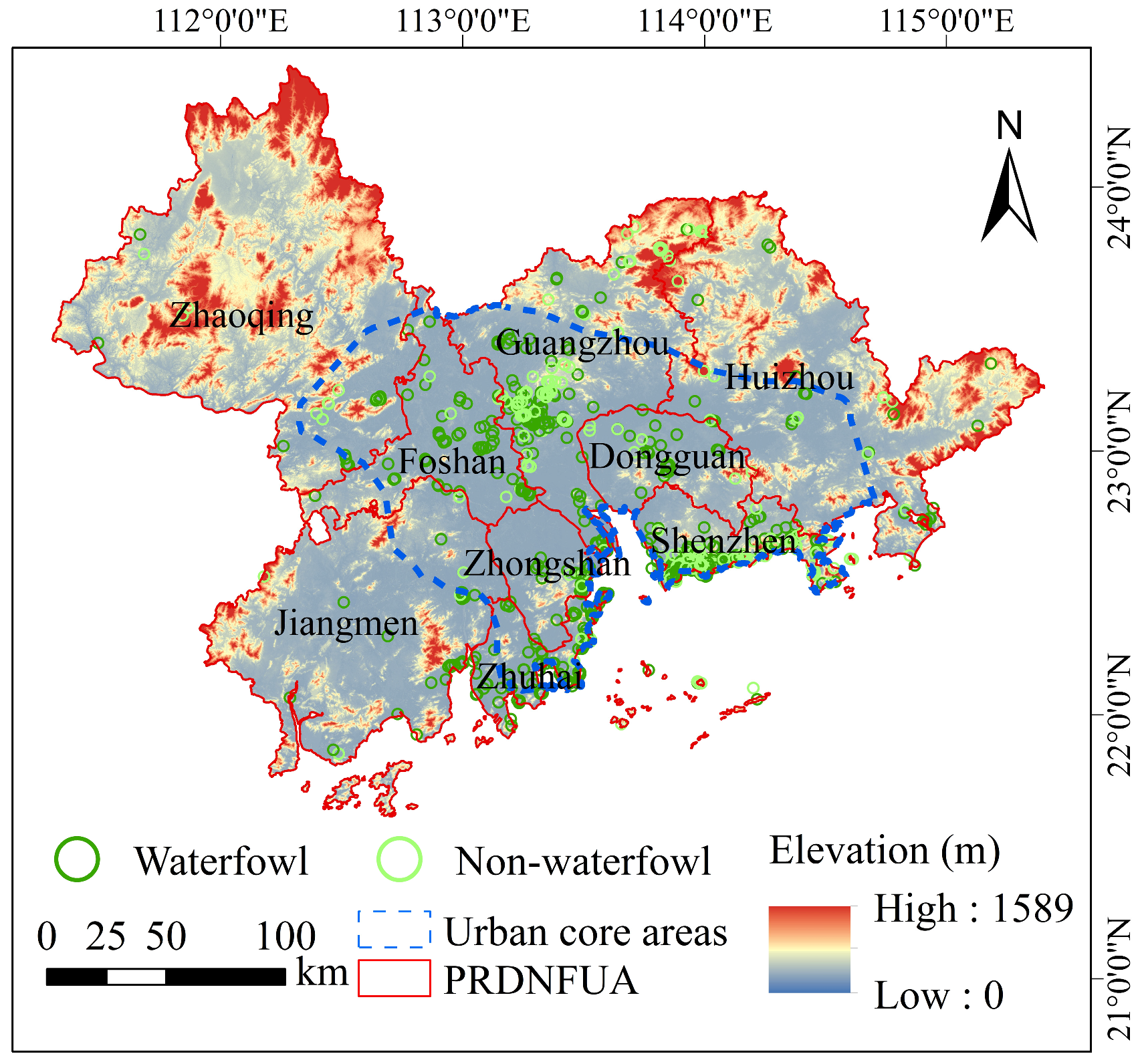
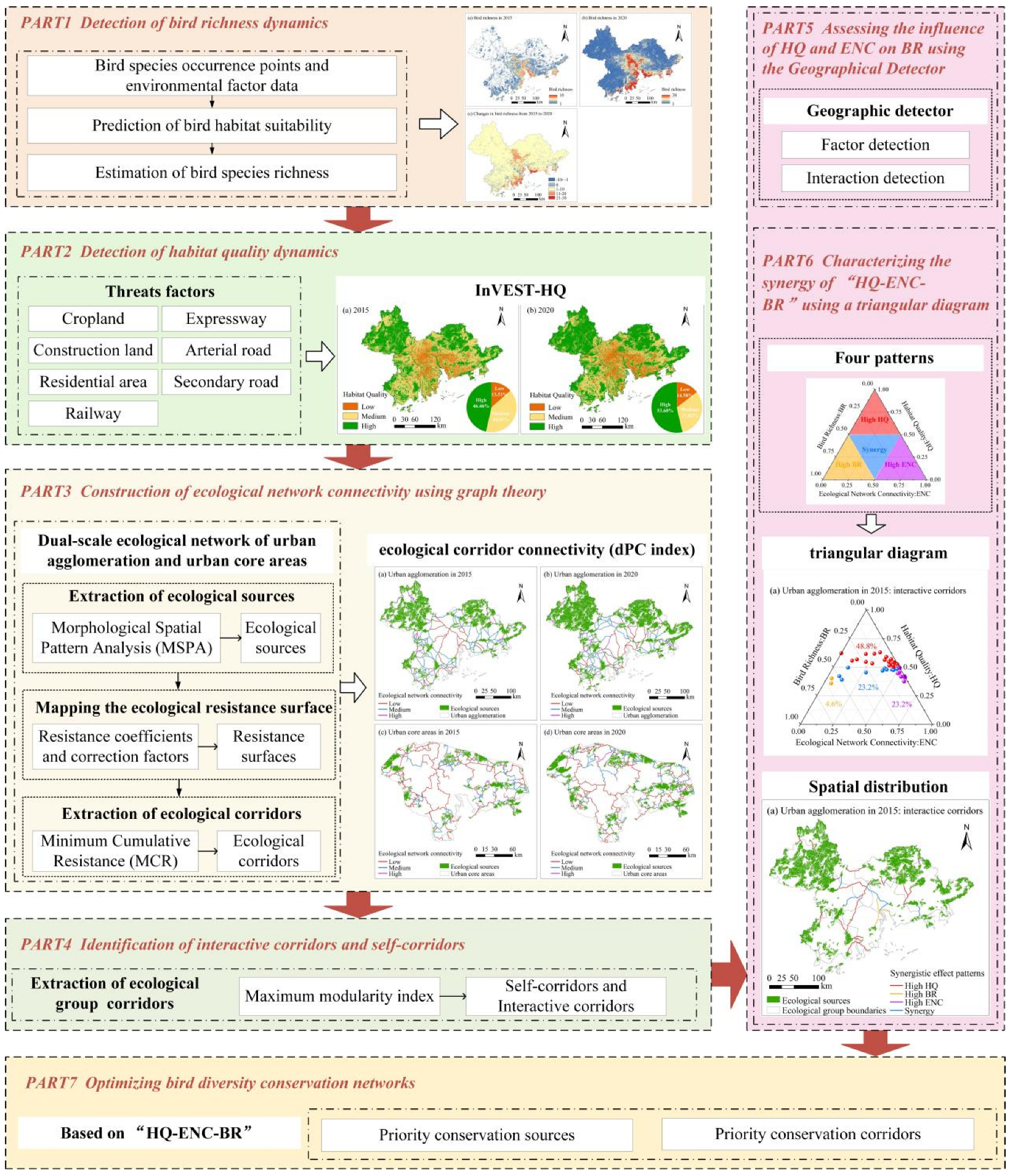
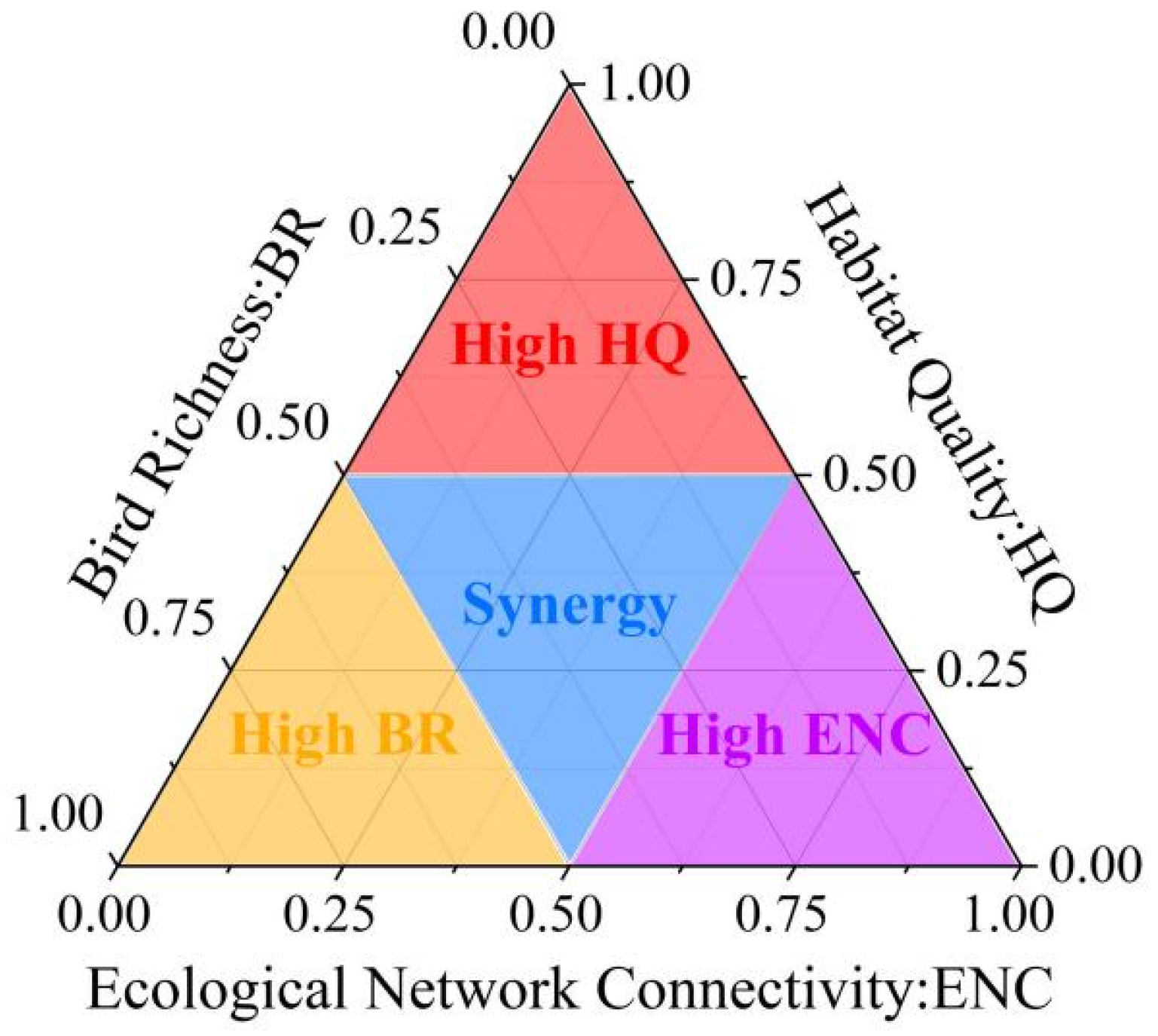
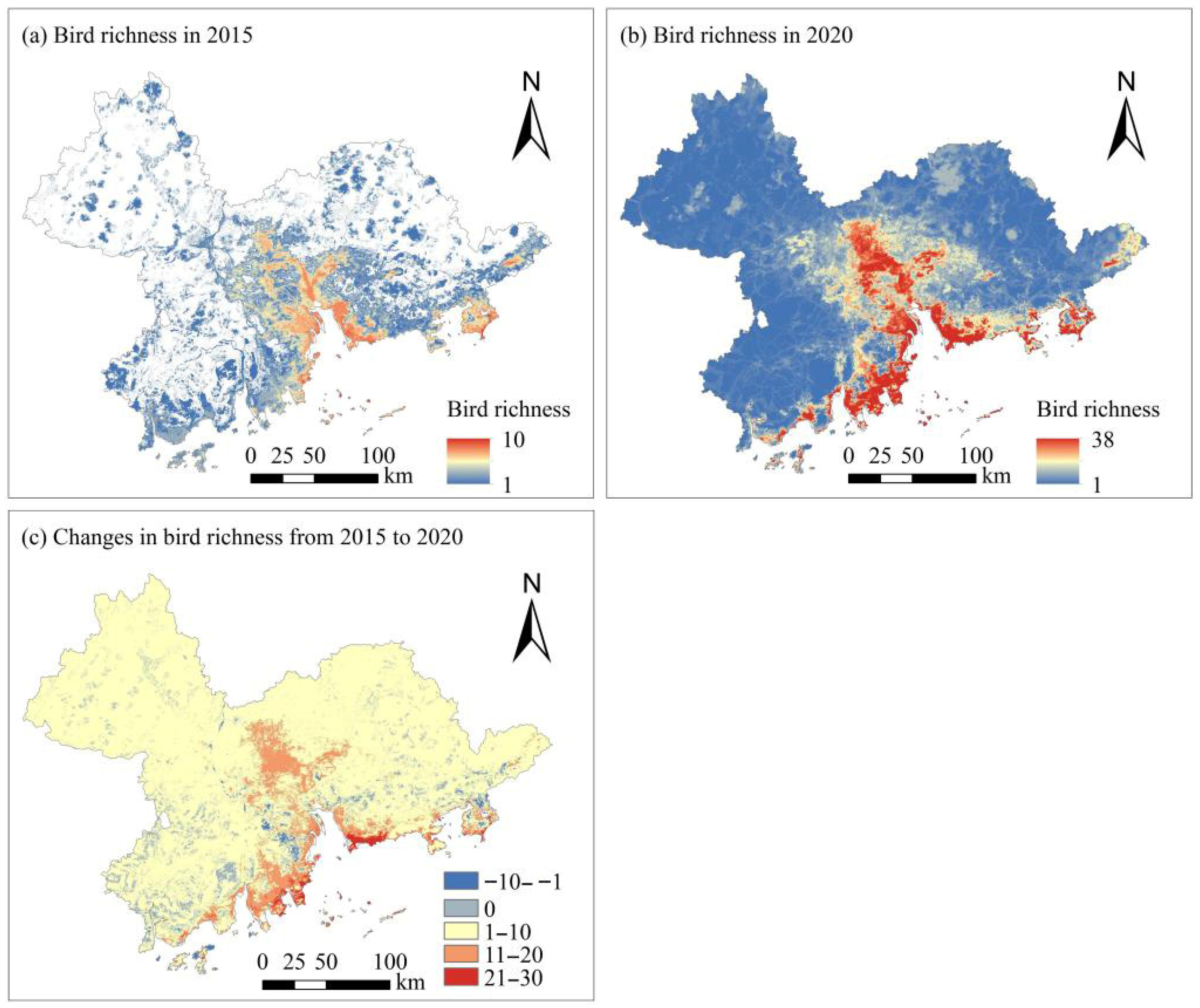
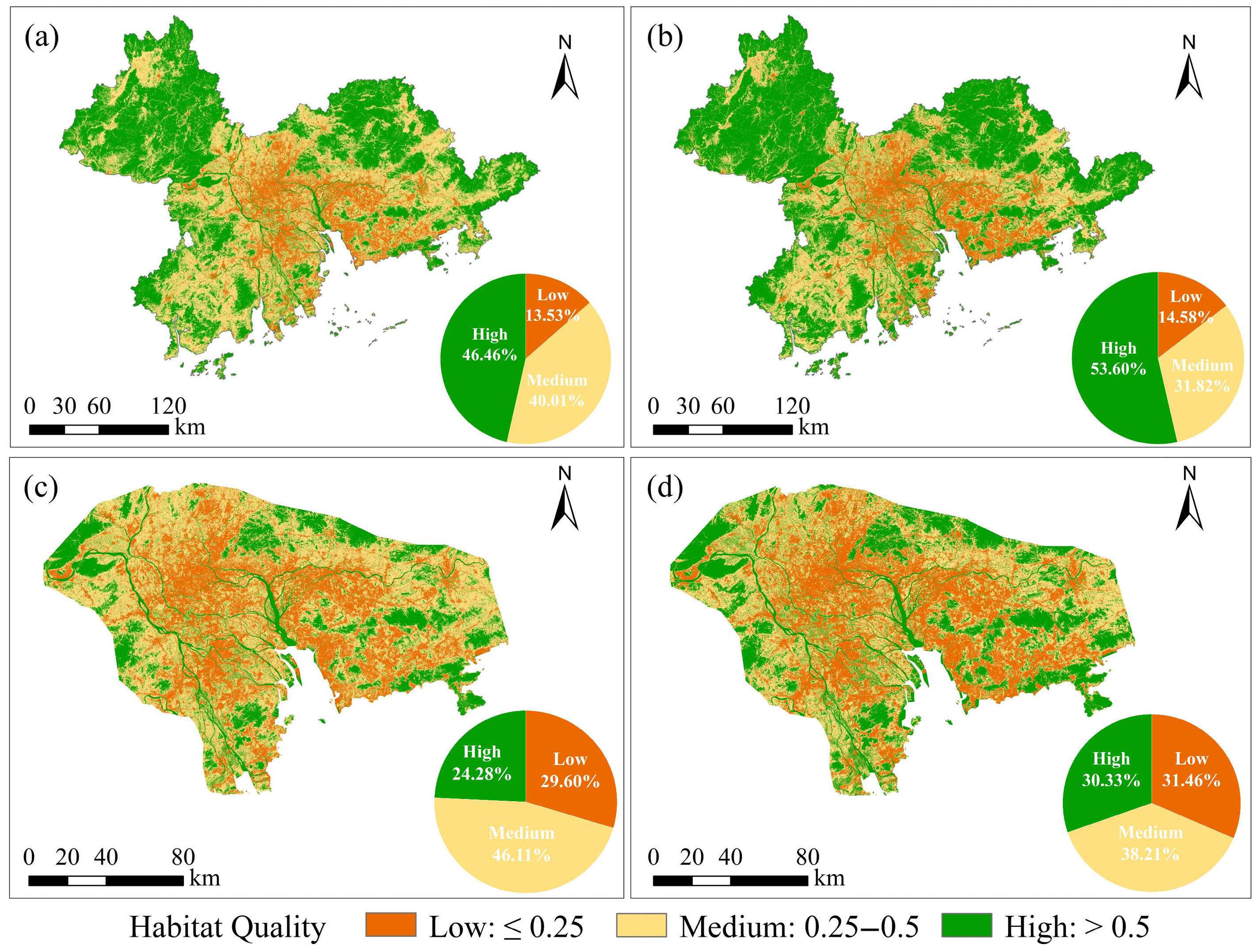
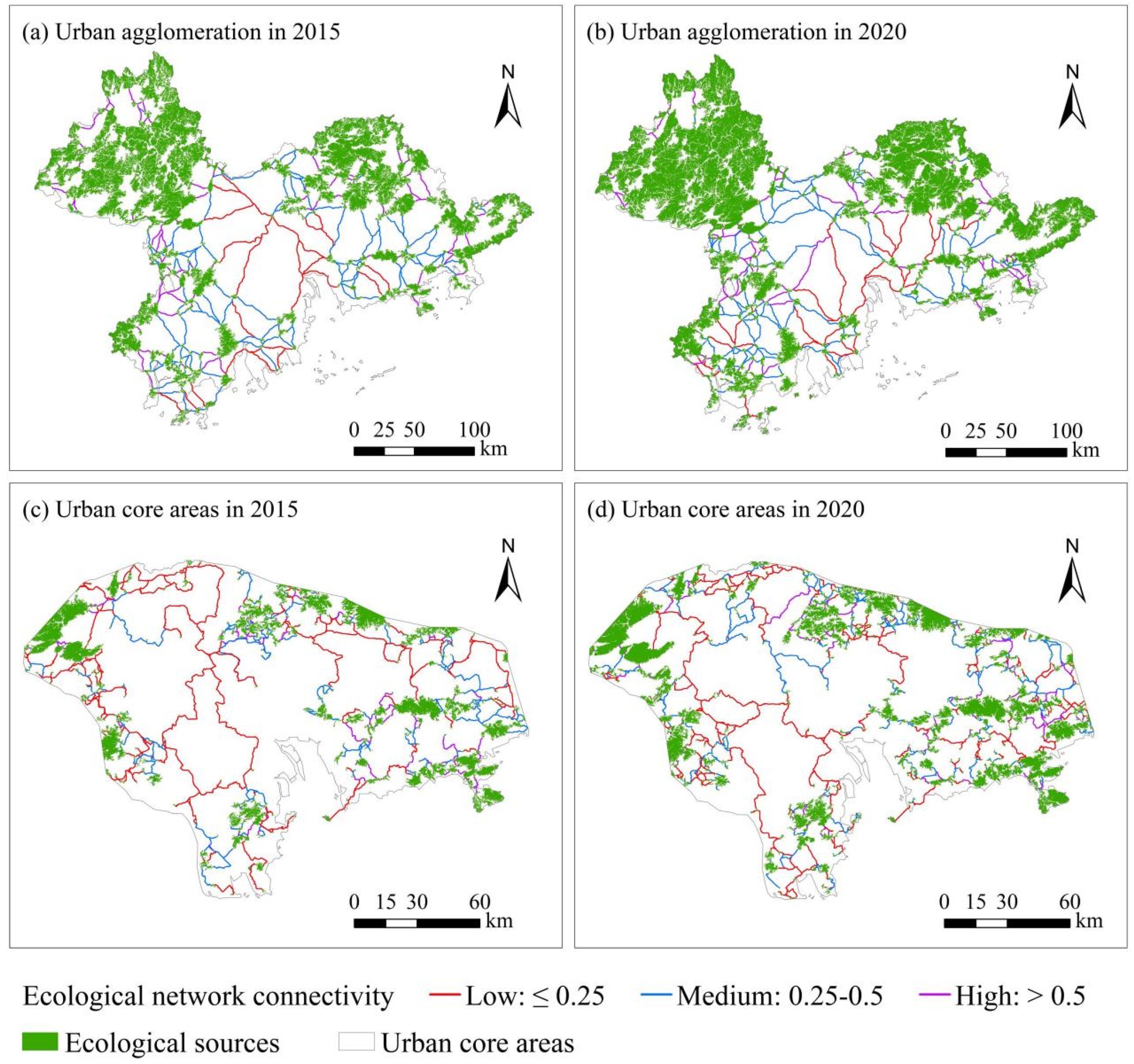
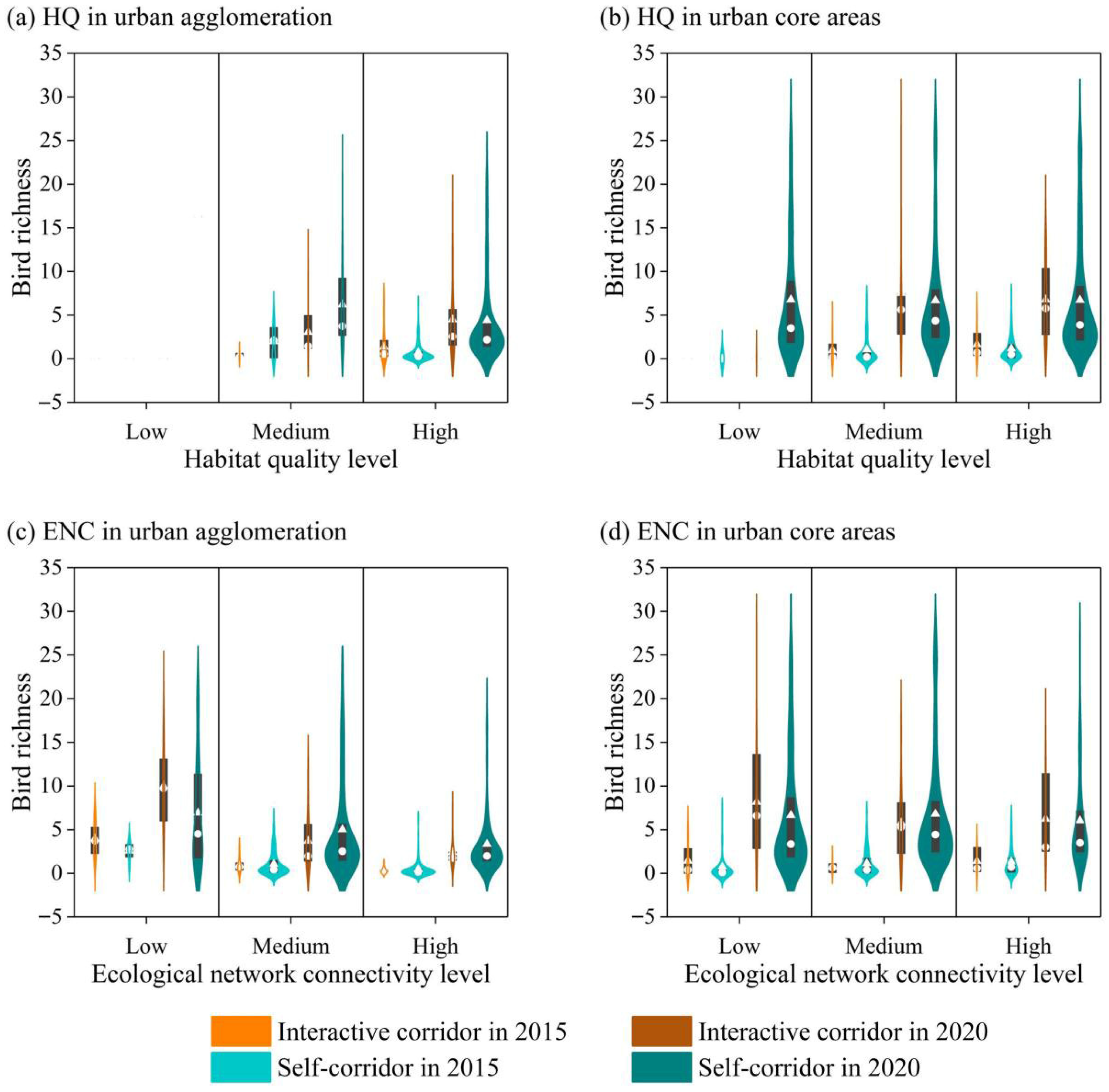
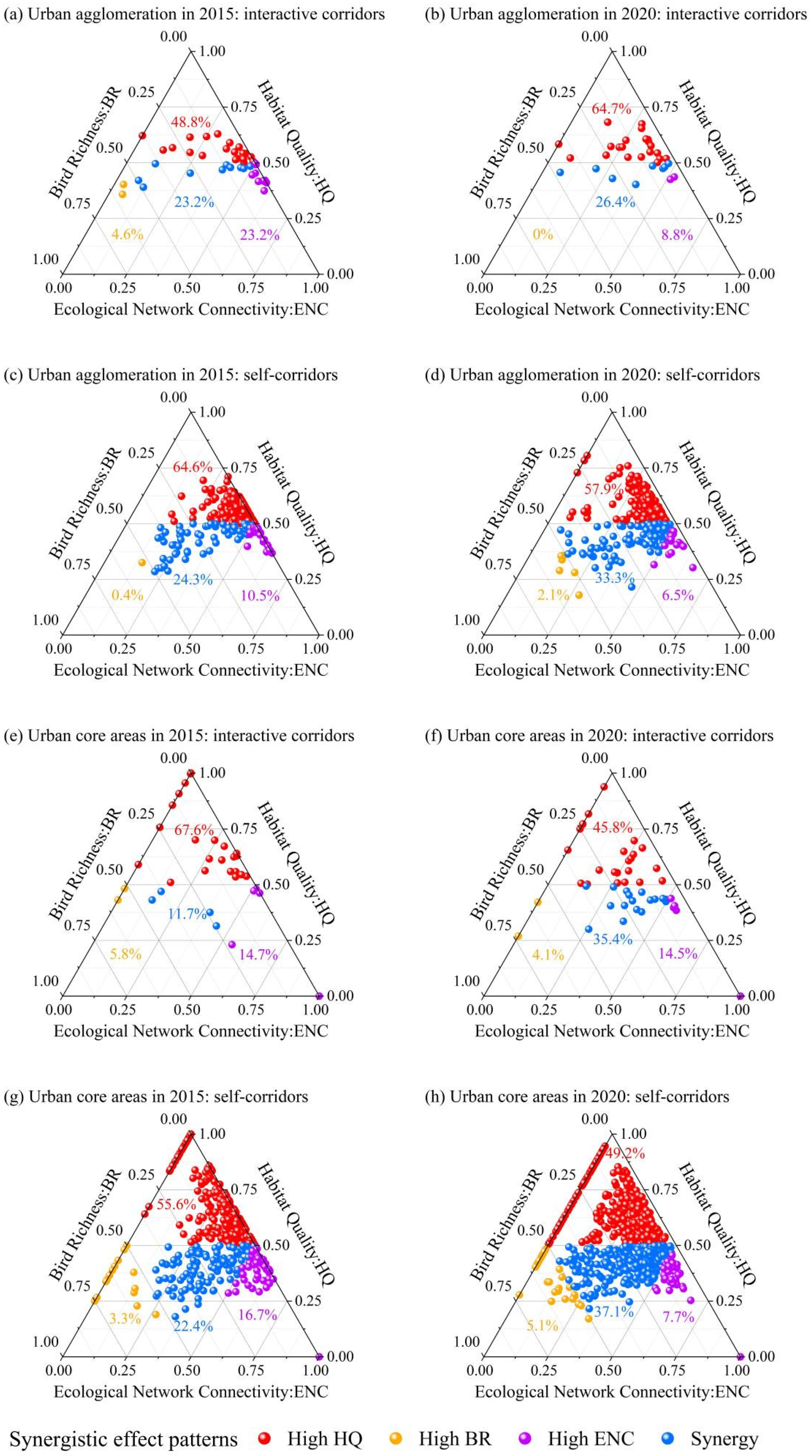
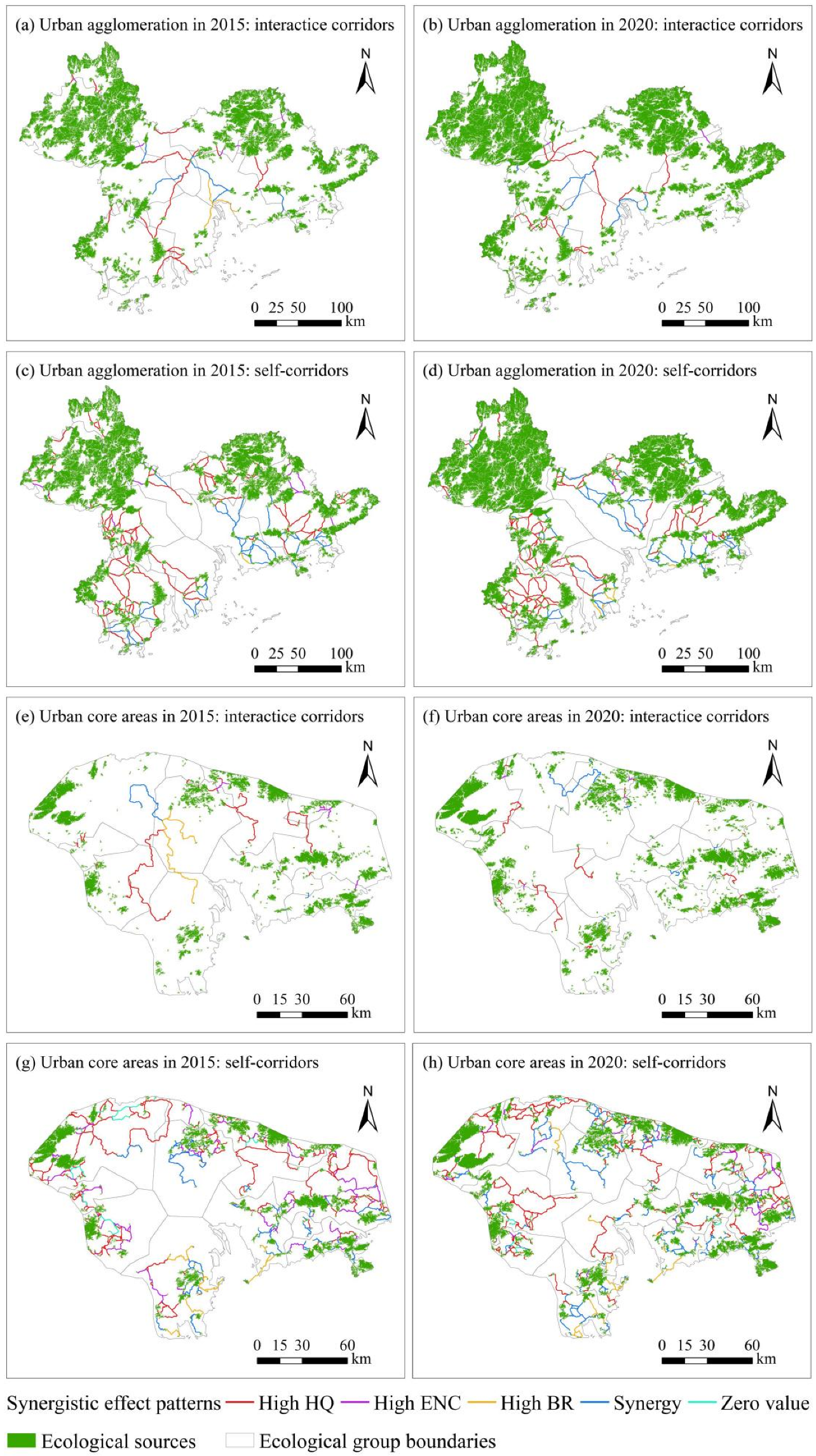
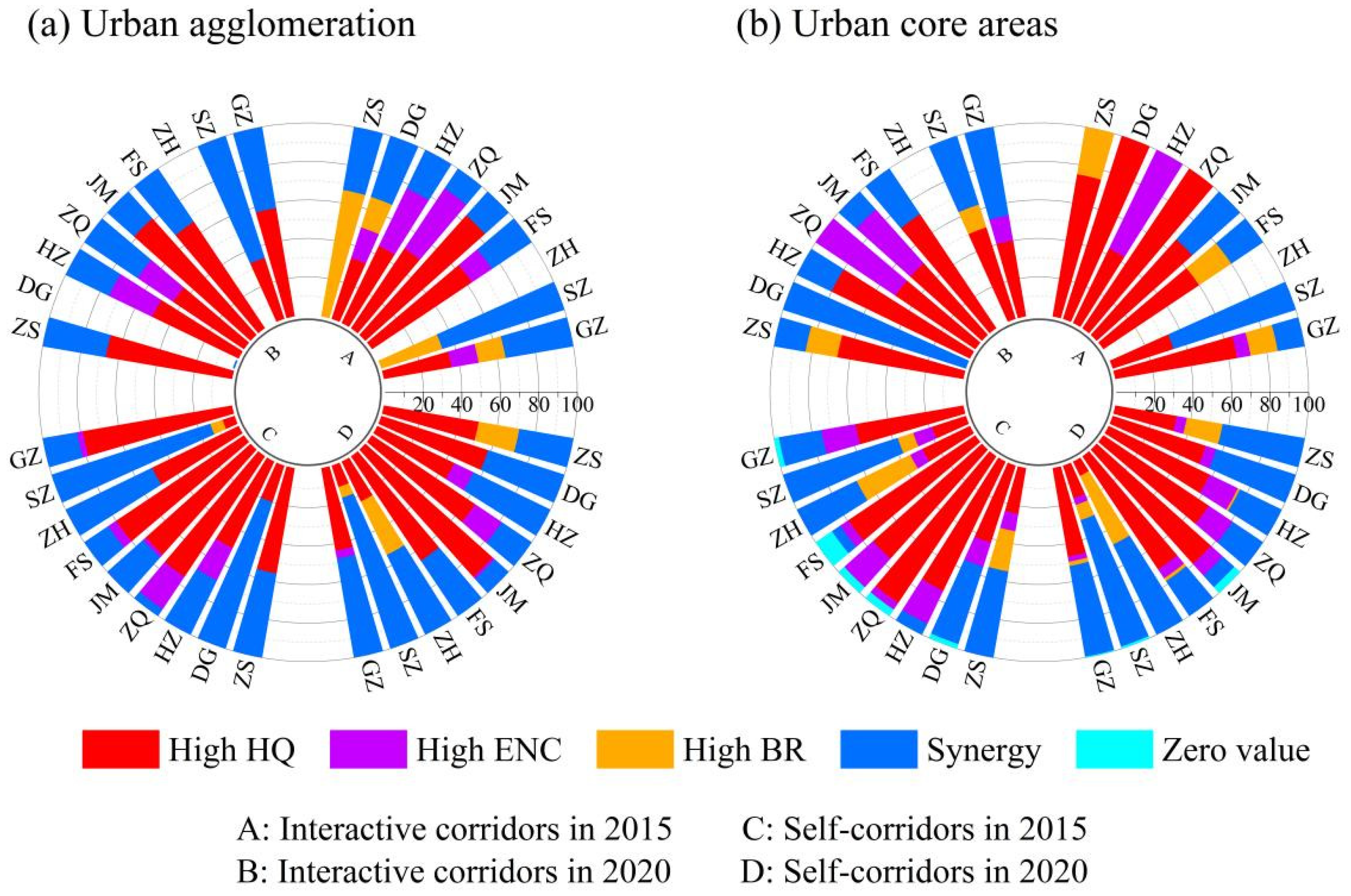
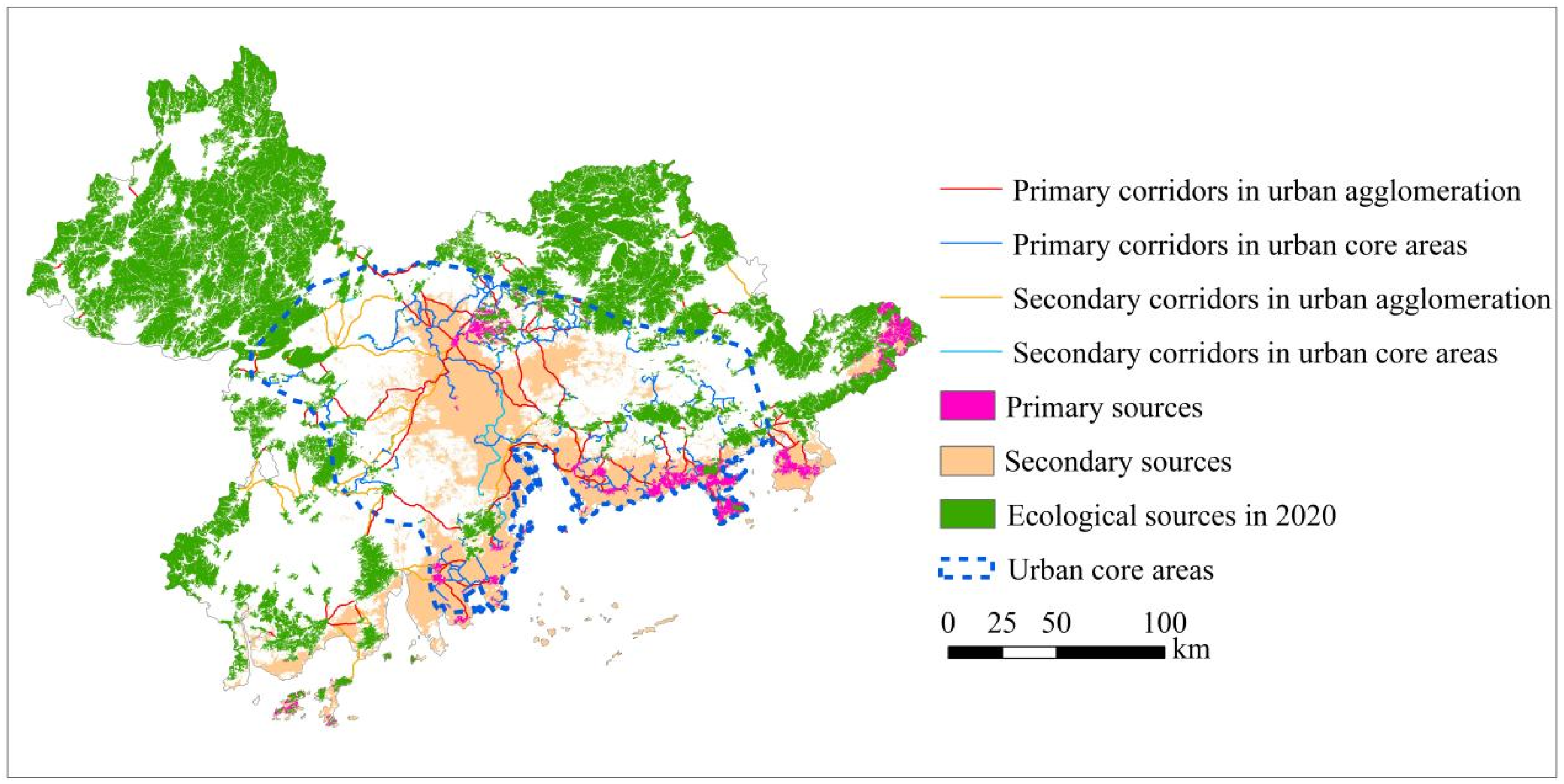

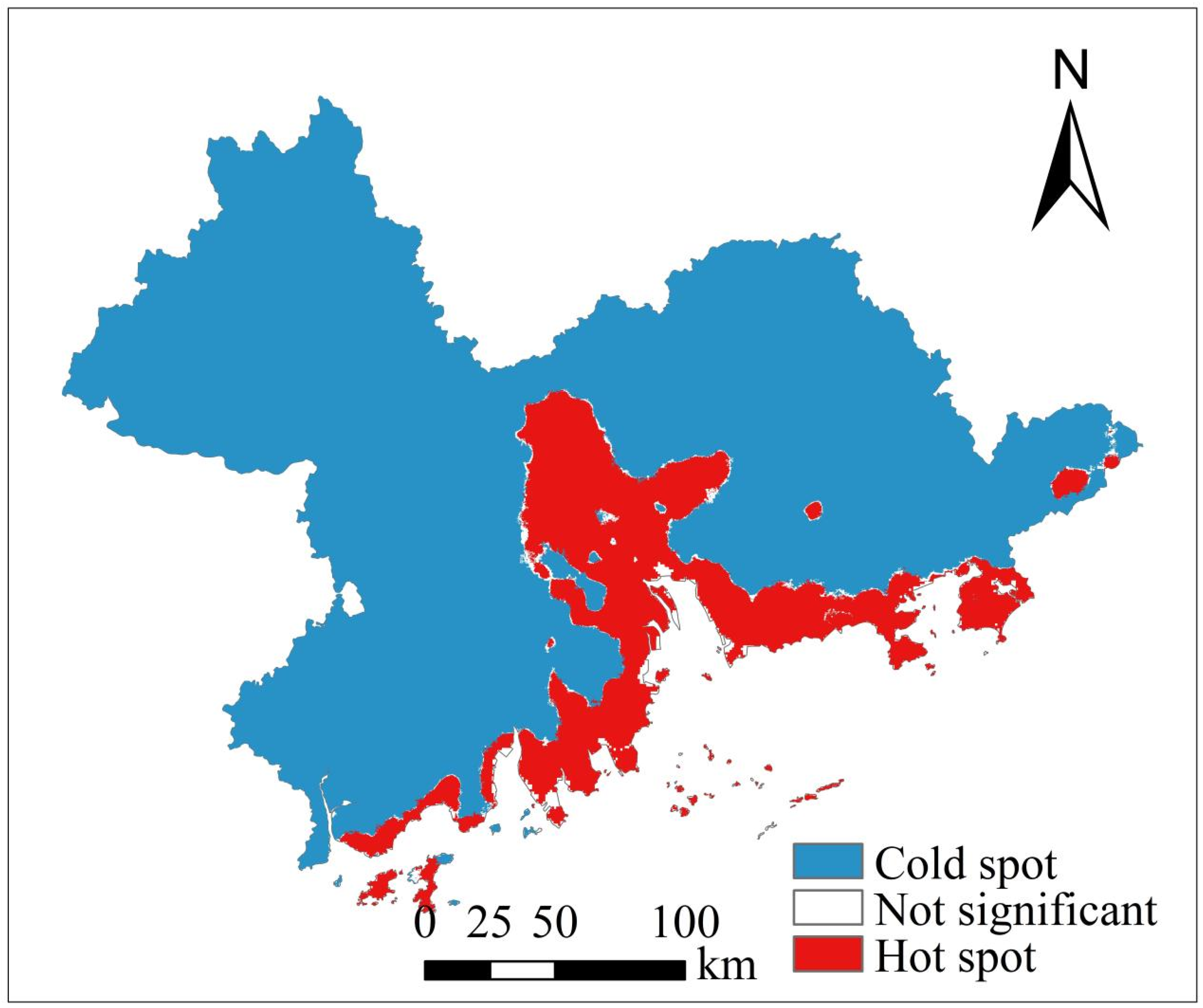
| Data | Time | Spatial Resolution | Source |
|---|---|---|---|
| Administrative boundary data | 2020 | - | National Catalogue Service For Geographic Information (https://www.webmap.cn/, accessed on 12 October 2023) |
| Urban extent data | 2020 | 1000 | A global dataset of annual urban extents (1992–2020) from harmonized nighttime lights [36] (https://doi.org/10.6084/m9.figshare.16602224.v1, accessed on 12 October 2023) |
| Land use data | 2015 | 30 | Earth Big Data Science Engineering Data Sharing Service System (http://data.casearth.cn/, accessed on 12 October 2023) |
| 2020 | |||
| Elevation | 2015 | 30 | Geospatial Data Cloud website (https://www.gscloud.cn/, accessed on 12 October 2023) |
| 2020 | |||
| Road network data | 2015 | - | National Catalogue Service For Geographic Information (https://www.webmap.cn/, accessed on 12 October 2023) |
| 2020 | |||
| Tourist attraction data | 2015 | - | BIGEMAP (http://www.bigemap.com/, accessed on 12 October 2023) |
| 2020 | |||
| Bird occurrence point data | 2011–2020 | - | Global Biodiversity Information Facility (GBIF Occurrence Download. Available online: https://doi.org/10.15468/dl.a3ufca, accessed on 12 October 2023) |
| Bioclimatic data | 1970–2000 | 1000 | WorldClim (https://www.worldclim.org/, accessed on 12 October 2023) |
| Land Cover Type | Habitat Suitability | Threat Factors | |||||||
|---|---|---|---|---|---|---|---|---|---|
| Cropland | CL | RA | Railway | Expressway | AR | SR | |||
| 1 | Cropland | 0.35 | 1 | 0.21 | 0.02 | 0.01 | 0.05 | 0.07 | 0.03 |
| 2 | Grassland | 0.40 | 0.08 | 0.06 | 0.02 | 0.02 | 0.02 | 0.03 | 0.03 |
| 3 | Forest | 1 | 0.55 | 0.41 | 0.2 | 0.21 | 0.23 | 0.25 | 0.25 |
| 4 | Shrub | 1 | 0.60 | 0.70 | 0.60 | 0.21 | 0.24 | 0.26 | 0.26 |
| 5 | Wetland | 1 | 0.12 | 0.09 | 0.02 | 0.01 | 0.01 | 0 | 0 |
| 6 | Construction land | 0 | 0.21 | 1 | 0.29 | 0.31 | 0.29 | 0.3 | 0.36 |
| 7 | Water | 0.90 | 0.08 | 0.06 | 0.01 | 0.02 | 0.04 | 0.03 | 0.01 |
| 8 | Unutilized land | 0 | 0.01 | 0.01 | 0 | 0.01 | 0 | 0 | 0 |
| Region | Year | Ecological Corridor Type | HQ (q Value) | ENC (q Value) | Interaction (q Value) | Interaction Types |
|---|---|---|---|---|---|---|
| Urban agglomeration | 2015 | Interactive corridors | 0.03 | 0.67 | 0.68 | V |
| Self-corridors | 0.08 | 0.14 | 0.23 | V | ||
| 2020 | Interactive corridors | 0.01 | 0.46 | 0.51 | V | |
| Self-corridors | 0.03 | 0.05 | 0.08 | V | ||
| Urban core areas | 2015 | Interactive corridors | 0.06 | 0.03 | 0.24 | V |
| Self-corridors | 0.03 | 0.02 | 0.06 | V | ||
| 2020 | Interactive corridors | 0.11 | 0.04 | 0.21 | V | |
| Self-corridors | 0.03 | 0.00 | 0.03 | V |
Disclaimer/Publisher’s Note: The statements, opinions and data contained in all publications are solely those of the individual author(s) and contributor(s) and not of MDPI and/or the editor(s). MDPI and/or the editor(s) disclaim responsibility for any injury to people or property resulting from any ideas, methods, instructions or products referred to in the content. |
© 2025 by the authors. Licensee MDPI, Basel, Switzerland. This article is an open access article distributed under the terms and conditions of the Creative Commons Attribution (CC BY) license (https://creativecommons.org/licenses/by/4.0/).
Share and Cite
Bai, N.; Fu, Y.; He, T.; Zhang, S.; Zhong, D.; Sun, J.; Yin, Z. Drivers of Bird Diversity in the Pearl River Delta National Forest Urban Agglomeration, Guangdong Province, China. Forests 2025, 16, 1590. https://doi.org/10.3390/f16101590
Bai N, Fu Y, He T, Zhang S, Zhong D, Sun J, Yin Z. Drivers of Bird Diversity in the Pearl River Delta National Forest Urban Agglomeration, Guangdong Province, China. Forests. 2025; 16(10):1590. https://doi.org/10.3390/f16101590
Chicago/Turabian StyleBai, Nana, Yingchun Fu, Tingting He, Si Zhang, Dongping Zhong, Jia Sun, and Zhenghui Yin. 2025. "Drivers of Bird Diversity in the Pearl River Delta National Forest Urban Agglomeration, Guangdong Province, China" Forests 16, no. 10: 1590. https://doi.org/10.3390/f16101590
APA StyleBai, N., Fu, Y., He, T., Zhang, S., Zhong, D., Sun, J., & Yin, Z. (2025). Drivers of Bird Diversity in the Pearl River Delta National Forest Urban Agglomeration, Guangdong Province, China. Forests, 16(10), 1590. https://doi.org/10.3390/f16101590








